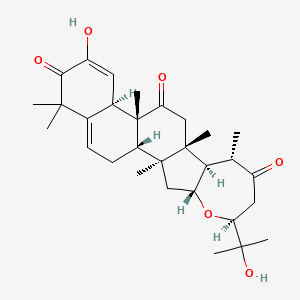| Authors | Title | Published | Journal | PubMed Link |
|---|---|---|---|---|
| Abbas S et al. | The cucurbitacins E, D and I: investigation of their cytotoxicity toward human chondrosarcoma SW 1353 cell line and their biotransformation in man liver. | 2013 | Toxicol. Lett. | pmid:23194827 |
| Gabrielsen M et al. | Cucurbitacin covalent bonding to cysteine thiols: the filamentous-actin severing protein Cofilin1 as an exemplary target. | 2013 | Cell Commun. Signal | pmid:23945128 |
| Ayyad SE et al. | In vitro and in vivo study of cucurbitacins-type triterpene glucoside from Citrullus colocynthis growing in Saudi Arabia against hepatocellular carcinoma. | 2012 | Environ. Toxicol. Pharmacol. | pmid:22245841 |
| Pan L et al. | Isolation, structure elucidation, and biological evaluation of 16,23-epoxycucurbitacin constituents from Eleaocarpus chinensis. | 2012 | J. Nat. Prod. | pmid:22239601 |
| Henrich CJ et al. | Effects of cucurbitacins on cell morphology are associated with sensitization of renal carcinoma cells to TRAIL-induced apoptosis. | 2012 | Apoptosis | pmid:21928090 |
| Chen X et al. | Biological activities and potential molecular targets of cucurbitacins: a focus on cancer. | 2012 | Anticancer Drugs | pmid:22561419 |
| Ren S et al. | Anti-proliferative effect of 23,24-dihydrocucurbitacin F on human prostate cancer cells through induction of actin aggregation and cofilin-actin rod formation. | 2012 | Cancer Chemother. Pharmacol. | pmid:22814677 |
| RÃos JL et al. | Cucurbitacins as inducers of cell death and a rich source of potential anticancer compounds. | 2012 | Curr. Pharm. Des. | pmid:22443631 |
| Bartalis J and Halaweish FT | In vitro and QSAR studies of cucurbitacins on HepG2 and HSC-T6 liver cell lines. | 2011 | Bioorg. Med. Chem. | pmid:21459003 |
| Lang KL et al. | New cytotoxic cucurbitacins from Wilbrandia ebracteata Cogn. | 2011 | Planta Med. | pmid:21472651 |
Cucurbitacin S
Cucurbitacin s is a lipid of Sterol Lipids (ST) class. The involved functions are known as establishment and maintenance of localization and nitric oxide biosynthetic process.
Cross Reference
Introduction
To understand associated biological information of Cucurbitacin S, we collected biological information of abnormalities, associated pathways, cellular/molecular locations, biological functions, related genes/proteins, lipids and common seen animal/experimental models with organized paragraphs from literatures.
What diseases are associated with Cucurbitacin S?
There are no associated biomedical information in the current reference collection.
No disease MeSH terms mapped to the current reference collection.
PubChem Associated disorders and diseases
What pathways are associated with Cucurbitacin S
There are no associated biomedical information in the current reference collection.
PubChem Biomolecular Interactions and Pathways
Link to PubChem Biomolecular Interactions and PathwaysWhat cellular locations are associated with Cucurbitacin S?
There are no associated biomedical information in the current reference collection.
What functions are associated with Cucurbitacin S?
Related references are published most in these journals:
| Function | Cross reference | Weighted score | Related literatures |
|---|
What lipids are associated with Cucurbitacin S?
There are no associated biomedical information in the current reference collection.
What genes are associated with Cucurbitacin S?
There are no associated biomedical information in the current reference collection.
What common seen animal models are associated with Cucurbitacin S?
There are no associated biomedical information in the current reference collection.
